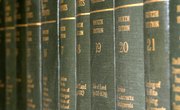Tip
As you write an article analysis, focus on writing a summary of the main points followed by an analytical critique of the author’s purpose.
Knowing how to write an article analysis paper involves formatting, critical thinking of the literature, a purpose of the article and evaluation of the author’s point of view. In an article analysis critique, you integrate your perspective of the author about a specific topic into a mix of reasoning and arguments. So, you develop an argumentative approach to the point of view of the author. However, a careful distinction occurs between summary and analysis.
When presenting your findings of the article analysis, you might want to summarize the main points, which allows you to formulate a thesis statement. Then, inform the readers about the analytical aspects the author presents in his arguments. Most likely, developing ideas on how to write an article analysis entails a meticulous approach to the critical thinking of the author.
Writing Steps for an Article Analysis
As with any formal paper, you want to begin by quickly reading the article to get the main points. Once you generate a general idea of the point of view of the author, start analyzing the main ideas of each paragraph. An ideal way to take notes based on the reading is to jot them down in the margin of the article. If that's not possible, include notes on your computer or a separate piece of paper. Interact with the text you're reading.
Becoming an active reader helps you decide the relevant information the author intends to communicate. At this point, you might want to include a summary of the main ideas. After you finish writing down the main points, read them to yourself and decide on a concise thesis statement. To do so, begin with the author’s name followed by the title of the article. Next, complete the sentence with your analytical perspective.
Ideally, you want to use outlines, notes and concept mapping to draft your copy. As you progress through the body of the critical part of the paper, include relevant information such as literature references and the author’s purpose for the article. Formal documents, such as an article analysis, also use in-text citation and proofreading. Any academic paper includes a grammar, spelling and mechanics proofreading. Make sure you double-check your paper before submission.
When you write the summary of the article, focus on the purpose of the paper and develop ideas that inform the reader in an unbiased manner. One of the most crucial parts of an analysis essay is the citation of the author and the title of the article. First, introduce the author by first and last name followed by the title of the article. Add variety to your sentence structure by using different formats. For example, you can use “Title,” author’s name, then a brief explanation of the purpose of the piece. Also, many sentences might begin with the author, “Title,” then followed by a description of the main points. By implementing active, explicit verbs into your sentences, you'll show a clear understanding of the material.
Much like any formal paper, consider the most substantial points as your main ideas followed by evidence and facts from the author’s persuasive text. Remember to use transition words to guide your readers in the writing. Those transition phrases or words encourage readers to understand your perspective of the author’s purpose in the article. More importantly, as you write the body of the analysis essay, use the author’s name and article title at the beginning of a paragraph.
When you write your evidence-based arguments, keep the author’s last name throughout the paper. Besides writing your critique of the author’s purpose, remember the audience. The readers relate to your perspective based on what you write. So, use facts and evidence when making inferences about the author’s point of view.
Description of an Article Analysis Essay
When you analyze an article based on the argumentative evidence, generate ideas that support or not the author’s point of view. Although the author’s purpose to communicate the intentions of the article may be clear, you need to evaluate the reasons for writing the piece. Since the basis of your analysis consists of argumentative evidence, elaborate a concise and clear thesis. However, don't rely on the thesis to stay the same as you research the article.
At many times, you'll find that you'll change your argument when you see new facts. In this way, you might want to use text, reader, author, context and exigence approaches. You don't need elaborate ideas. Just use the author’s text so that the reader understands the point of views. However, evaluate the strong tone of the author and the validity of the claims in the article. So, use the context of the article.
Then, ask yourself if the author explains the purpose of his or her persuasive reasons. As you discern the facts and evidence of the article, analyze the point of views carefully. Look for assumptions without basis and biased ideas that aren't valid. An analysis example paragraph easily includes your perspective of the author’s purpose and whether you agree or not. Don't be surprised if your critique changes as you research other authors about the article.
Consequently, your response might end up agreeing, disagreeing or being somewhat in between despite your efforts of finding supporting evidence. Regardless of the consequences of your research of the literature and the perspective of the author’s point of view, maintain a definite purpose in writing. Don't fluctuate from agreement and disagreement. Focusing your analysis on presenting the points of view of the author so readers understand it and disseminating that critique is the basis of your paper.
When reading the text carefully, analyze the main points and explain the reasons of the author. Also, as you describe the document, offer evidence and facts to eliminate any biases. In an argumentative analysis, the focus of the writer can quickly shift. Avoid ineffective ways of approaching the author’s point of view that make the writing vague and lack supporting evidence. A clear way to stay away from biases is to use quotes from the author. However, using excessive amounts of quotes is counterproductive. Use author quotes sparingly.
As you develop your own ideas about the author’s viewpoints, use deductive reasoning to analyze the various aspects of the article. Often, you'll find the historical background influenced the author or persuaded the author to challenge the ideals of the time. Distinguishing between writing a summary and an analysis paper is crucial to your essay. You might find that using a review at the beginning of your article indicates a clear perspective to your analysis. Hence, a summary explains the main points of a paper in a concise manner.
You condense the original text, describe the main points, write your thesis and form no opinion about the article. On the other hand, an analysis is the breakdown of the author’s arguments that you use to derive the purpose of the author. When analyzing an article, you're dissecting the main points to draw conclusions about the persuasive ideas of the author. Furthermore, you offer argumentative evidence, strengths and weaknesses of the main points. More importantly, you don't give your opinion. Rather than providing comments on the author’s point of views, you compile evidence of how the author persuades readers to think about a particular topic and whether the author elaborates it adequately.
Examples of an Article Analysis
A summary and analysis essay example illustrates the arguments the author makes and how those claims are valid. For instance, a sample article analysis of “Sex, Lies, and Conversation; Why Is It So Hard for Men and Women to Talk to Each Other” by Deborah Tannen begins with a summary of the main critical points followed by an analytical perspective. One of the precise ways to summarize is to focus on the main ideas that Tannen uses to distinguish between men and women.
The writer of the summary also clearly states how one idea correlates to the other without presenting biases or opinions. Also, the writer doesn't take any sides on whether men or women are to blame for miscommunication. Instead, the summary points to the communication differences between men and women. In the analytical section of the sample, the writer immediately takes a transparent approach to the article and the author. The analysis shows apparent examples from the article with quotes and refers back to the article connecting miscommunication with misinterpretation. Finally, the writer poses various questions that Tannen didn't address, such as strategies for effective communication. However, the writer gives the reader the purpose of Tannen’s article and the reasons the author wrote it.
Another example of an article analysis is “The Year That Changed Everything” by Lance Morrow. The writer presents a concise summary of the elected government positions of Nixon, Kennedy and Johnson. Furthermore, the writer distinguishes between the three elected men's positions and discusses the similarities. The summary tends to lean toward a more powerful tone but effectively explains the author’s point of view for each one of these men. Then, the writer further describes the ideals of the period between morality and immoral values. The analytical aspect of the sample shows the reader the author’s powerful message.
The writer immediately lets the reader know about the persuasive nature of the article and the relevance of the time. For instance, the writer shows the reader in various parts of the article by suggesting examples in specific paragraph numbers. The writer also makes a powerful impact with the use of quotes embedded into the text. The writer uses transition words and active verbs, such as more examples, links, uncovering and secrets, and backs this claim up to describe Morrow’s purpose for the article. The analysis has the audience in mind.
The writer points out the specific details of the time era that only people of the time would relate. More importantly, the writer analyzes Morrow’s ideas as critical to formulating an opinion about Nixon, Kennedy and Johnson. However, the writer points out the assumptions Morrow makes between personal lifestyle and how it affects the political arena. Moreover, the writer suggests that Morrow’s claims aren't entirely valid just because the author mentions historical events. Unlike Tannen’s analytical example, the writer lets the readers know the misconnection between moral value and the lifestyle of many people at the time.
Both article analyses show a clear way to present different persuasive points of view. Unlike a summary, an analysis approach offers the reader an explicit representation of the author’s viewpoints without any opinions. The writers of each sample focus on providing evidence, facts and reasonable statements. Consequently, each example demonstrates the proper use of the critical analysis of the literature and evaluates the purpose of the author. Without seeking an agreement or not, the writer clearly distinguishes between a summary and an analysis of each article.
Related Articles
References
Writer Bio
Barbara earned a B. S. in Biochemistry and Chemistry from the Univ. of Houston and the Univ. of Central Florida, respectively. Besides working as a chemist for the pharmaceutical and water industry, she pursued her degree in secondary science teaching. Barbara now writes and researches educational content for blogs and higher-ed sites.











